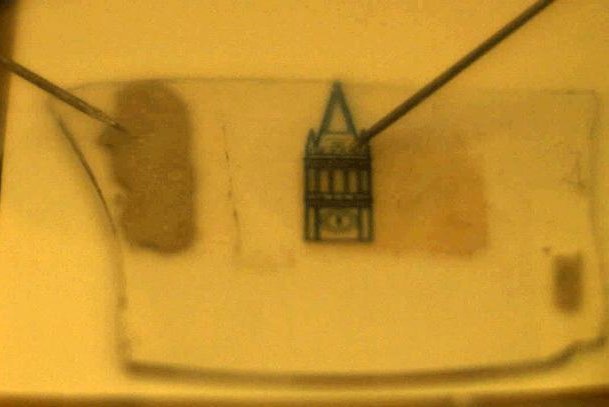The light-emitting monolayer semiconductor display is just three-atoms thick. Photo by Javey Lab/Berkeley
March 26 (UPI) -- Engineers have developed a light-emitting display so thin it disappears when turned off.
The device, designed by scientists at the University of California, Berkeley, was built using a monolayer semiconductor and measures just three-atoms thick.
"The materials are so thin and flexible that the device can be made transparent and can conform to curved surfaces," Der-Hsien Lien, a postdoctoral fellow at Cal, said in a news release.
In 2015, Ali Javey, a professor of electrical engineering and computer sciences at Berkeley, published research showing monolayer semiconductors are capable of emitting bright light. The latest research, published this week in the journal Nature Communications, expands on Javey's work.
Scientists working in Javey's lab were able to overcome a number of technological barriers and scale-up monolayer semiconductor technology described in 2015 by several orders of magnitude. By scaling-up the technology, researchers were able to stretch the semiconductor's lateral dimensions enough to create a display capable of emitting bright light.
Light-emitting semiconductors require a pair of "contacts," or inputs, to deliver a negative and positive charge. This necessity has limited the ability of engineers to shrink the thickness of semiconductor displays.
The new ultra thin device designed by Berkeley researchers features only a single contact. By laying the semiconductor monolayer on an insulator embedded with electrodes, engineers were able to deliver an AC current that switches from positive to negative. The two charges move simultaneously through the semiconductor, causing the device to emit light.
The proof-of-concept device is not very energy efficient, but with future improvements, scientists hope the technology could pave the way for an invisible smart display that could be installed on walls and windows -- or even used to create light-up tattoos.
"A lot of work remains to be done and a number of challenges need to be overcome to further advance the technology for practical applications," Javey said. "However, this is one step forward by presenting a device architecture for easy injection of both charges into monolayer semiconductors."















